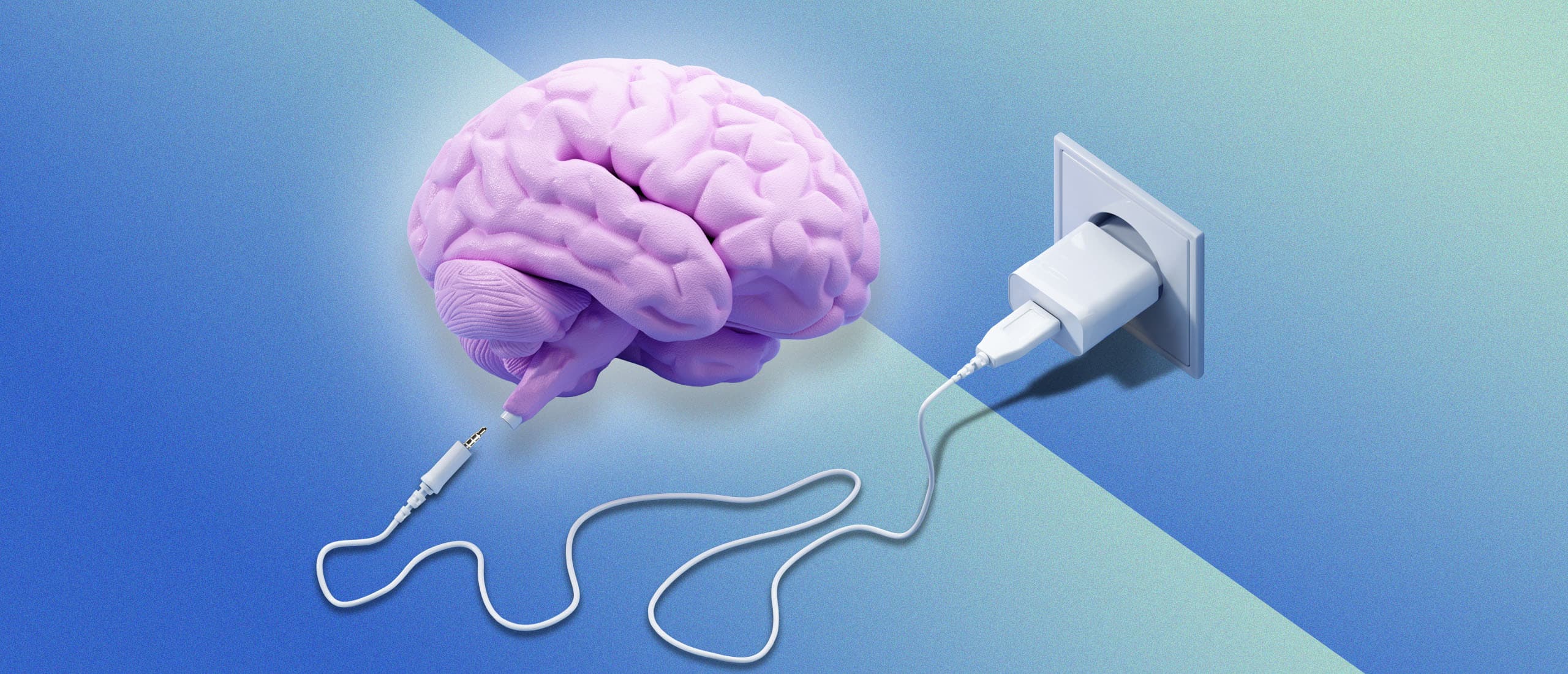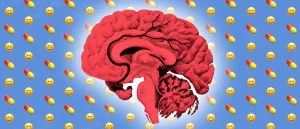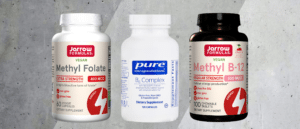Reboot Your Brain With a Dopamine Detox
- By Stephanie Anderson Witmer
- Fact-checked by Joy Ferguson
- January 18, 2024
The concept of fasting is nothing new—intermittent fasting and even sexual fasting have huge followings. Now a new kind of fasting is creating a buzz: dopamine detox. More than 50,000 people are subscribed to the Dopamine Detoxing subreddit and neuroscientist Andrew Huberman, Ph.D. regularly and extensively discusses dopamine fasting on his Huberman Lab podcast. So it’s got to be good.
But, hold up. Isn’t dopamine supposed to help us feel good?
Dopamine Explained
Dopamine is the brain’s reward-motivation chemical. Engaging in pleasurable activities (sex, exercise, the smell of ribs smoking), gives you a rush of the feel-good stuff. When you do something you like, dopamine helps you remember you like it—and motivates you to keep doing it.
And it’s more than just liking something, research shows: Dopamine makes you want more of it (1).
And therein lies the problem, according to proponents of dopamine fasting. Some experts think that you can get too reliant on these bursts.
For some, addictive (dopamine-related) behaviors like too much phone time and constant scrolling on social media erode our focus and attention. For others, dopamine hits could come via risky behavior or substance abuse.
But can you actually reset your brain so you can detach from these behaviors? Is it possible to regulate dopamine—and should you try?
Your Brain on Dopamine
Dopamine is one of the four “feel-good” hormones released by the brain, along with serotonin, oxytocin, and endorphins. Dopamine is a neurotransmitter, meaning it sends messages from nerve cells to the next nerve, muscle, or gland to control certain bodily functions.
Dopamine is also known as the “reward” hormone (2). The release of dopamine is that rush you feel when you do something pleasurable, like buying a new set of adjustable dumbbells for your home gym or splurging on sweets. It reinforces and reminds you that this behavior feels good—which is why you want to do it again and again.
But that’s not all. Dopamine helps to control memory, cognition, emotion, focus, and movement.
People with symptomatic Parkinson’s disease, for instance, have an 80% or larger reduction in dopamine production, according to the American Association of Neurological Surgeons, which leads to tremors, impaired coordination, and other movement-related symptoms.
Some other neurological and mental-health conditions, such as Huntington’s disease, depression, ADHD, and schizophrenia may also stem from too little or too much dopamine.
Can dopamine be too much of a good thing?
You can’t forgo dopamine altogether, as it helps control your moods, movement, and memory. But can you actually control your dopamine levels?
“Your brain is a sophisticated and complex organ that generally manages dopamine regulation on its own,” says Sam Zand, D.O., a clinical psychiatrist and co-founder and chief medical officer at Better U. “Problems can arise, though, when certain excessive pleasurable behaviors or substance abuse lead to an overstimulation of dopamine production.”
Dopamine’s reward-reinforcement mechanism is what’s at play in addiction. Take cocaine, for example (3). The drug binds to dopamine transporters, preventing the removal of dopamine and prolonging that feel-good sensation when people get high.
So not only does the high feel good by creating a flood of dopamine (the reward), but it’s also teaching your brain it needs it (the reinforcement).
Continued use of the drug will tamp down the reward-reinforcement you experience from other things. Over time, people build a tolerance, needing more of it to feel even marginally good.
It’s not just drugs that can short-circuit dopamine regulation. People can experience mild to full-blown addictions to video games, apps, online shopping, social media, gambling, sex and porn—needing more and more just to reach a “normal” baseline.
What Is Dopamine Detox?
“Dopamine detox helps to rebalance your brain’s reward system, which is thought to become desensitized over time from overstimulation,” Zand says. “In theory, by reducing dopamine triggers, the brain’s reward system becomes more sensitive to smaller amounts of dopamine. The concept is akin to delayed gratification, enhancing our future reward system.”
In 2017, a man named Greg Kamphuis published a blog and a book about the 40-day dopamine fast he created for himself to quit smoking and drinking while he was living in Cambodia.
But the practice didn’t catch on until a few years later and is most often credited to Cameron Sepah, Ph.D., an assistant clinical professor of psychiatry at University of California San Francisco.
Sepah wrote in a 2019 LinkedIn article that dopamine fasting is based on techniques from cognitive-behavioral therapy (CBT).
The first CBT technique at use is “stimulus control,” which involves restricting the external stimuli. Instead of simply relying on willpower to stop scrolling on social media, for example, you remove the stimulus (for example, by putting your phone in another room).
The other technique is what Sepah called “exposure and response prevention,” which means restricting the internal stimuli. One way to do this is to practice “urge surfing.” If you notice the urge to raid the snack cabinet or zone out on YouTube when you’re stressed, you ride the wave: you watch the urge build in intensity, peak, then gradually fade. Practiced regularly, this weakens the desire to seek activities that provide quick dopamine bursts.
The idea is that the constant buzz of reward that comes from social-media likes, video-game wins, or stress-snacking reconfigures the dopamine baseline and makes it addictive. But dopamine isn’t the only brain chemical that’s tied to pleasure, so it’s hard to know how much impact limiting these activities will really have.
“In theory, dopamine detoxes aim to ‘reset’ the brain to stop craving dopamine bursts so often and intensely,” says Michael Green, M.D., a board-certified family medicine doctor, OB/GYN, and chief medical officer of Winona.
The truth about dopamine fasting
While it’s a buzzy trend, dopamine detoxing is also often misunderstood. Sepah himself has sought to dispel the myths and misconceptions around the practice.
First, dopamine detox is not about ridding ourselves of dopamine or pleasure. Instead, according to Sepah, the ‘detox’ focuses on reducing specific behaviors that are problematic, which differ from person to person.
“To be clear,” Sepah wrote, “we are not fasting from dopamine itself, but from impulsive behaviors reinforced by it.”
A Step-by-Step Guide to Dopamine Detox
Behavior becomes problematic, Sepah wrote, when activities begin to cause distress, impairment, and addictiveness. So, using the internet for work is OK, but excessive scrolling and clicking—what Sepah calls “constant attentional switching (and thus dopaminergic firing)”—may be problematic.
Sepah created fasting or “feasting” schedules as guidelines, depending on the degree to which you’d like to limit problematic behavior. His fasting schedule recommends eliminating problematic behaviors for:
- one to four hours at the end of the day, starting with one hour and gradually adding more time
- one weekend day
- one weekend per quarter
- one week per year
The “feasting” schedule allows you to engage in the behavior daily but only with strict time limitations: five to 30 minutes a day, one to three times a day.
How to Regulate Your Dopamine Levels Naturally
Green thinks we probably all could benefit from a digital detox now and then, if not a full-fledged fast. “Any one of us might be staring at various screens all day, scrolling through social media, eating junk food, or doing things that do not make a significant long-term investment in our health,” he says.
Incorporate mindfulness and meditation practices
Sepah has said dopamine fasting is not “rebranding meditation/asceticism/sabbath.”
The practice of mindfulness and meditation may be helpful in treating addiction, for example. But there’s very little research looking specifically at mindfulness and meditation and their effect on dopamine production or regulation (4).
Still, allowing your brain to chill now and then is probably a good idea, Green says: “By pursuing meditation, sitting quietly in nature, reading, or other low-stimulus activities that do not require external stimulation, you can give your brain a break from that hyperactivated dopamine cycle.”
Eat foods that promote dopamine balance
Another way to produce more dopamine naturally is to incorporate the right foods into our diets. Dopamine synthesis is aided by an amino acid called tyrosine, which is found in certain foods. Tyrosine-rich foods include meat, nuts, eggs, fish, cheese, beans, and tofu.
A 2017 study found a link between tyrosine and enhanced cognitive performance (5).
Do a cold plunge or ice bath
Andrew Huberman has written about the benefits of cold exposure for the brain and body. And research has linked submersion in cold water to significant and sustained increases in dopamine (6).
According to Huberman, 11 weekly minutes of cold exposure can be enough to generate benefits.
Maximize Dopamine Detox Benefits
“Proponents of dopamine detox claim benefits such as improved focus, reduced dependency on instant gratification, better stress management, and more appreciation for simple pleasures in life,” Zand says.
It’s not clear how long the benefits last or how frequently you’d need to fast in order to see them.
“The duration of these benefits is said to vary among individuals and depends largely on their lifestyle post-detox,” Zand says.
Adopt healthy habits
Lifestyle factors matter, particularly the trifecta of exercise, sleep, and nutrition. Here’s how:
- Exercise is linked to increased levels of both dopamine and serotonin.
- Sleep deprivation has been found to affect dopamine levels.
- A balanced diet with plenty of protein, gut-friendly probiotics, vitamin D, and omega-3 fatty acids may help regulate dopamine levels, as well (7).
“Rather than focusing on controlling dopamine as a neurochemical, it may be more beneficial to cultivate a balanced lifestyle,” Zand says. “This includes regular physical exercise, a healthy diet, good sleep hygiene, mindfulness practices, and fostering positive relationships. These habits not only contribute to overall wellbeing but also facilitate healthy brain function.”
Cultivate new hobbies
Discovering new interests can help curb cravings. Try ones that don’t require tech-heavy stimulation.
Exercise for example, can beat stress and boost dopamine levels at the same time (8). Try hiking, biking, or rucking, since getting outside has an extra bonus: Research on seasonal affective disorder has found a link between exercise and dopamine regulation (8).
“If we always train ourselves to crave and follow short-term dopamine, we will always seek it out,” Green says. “By taking time to detox away from these activities that do not contribute to our long-term happiness and sustainability, we can ground ourselves in a better perspective and be less dependent on constant external stimulation.”
Seek professional help
For some, a once-in-a-while dopamine detox might not be enough.
“If you are struggling with impulse control, addiction, or lack of motivation, seeking help from a mental-health professional is likely to be more beneficial than merely attempting a dopamine detox on your own,” Zand says. “Remember, it’s crucial to approach mental health with care, understanding, and the help of professionals when needed.”
References
1. Berridge, K. & Robinson, T., (2016). Liking, Wanting and the Incentive-Sensitization Theory of Addiction
2. Lewis, R., et al. (2021) The Brain’s Reward System in Health and Disease
3. National Institute on Drug Abuse, (2016). Cocaine Research Report
4. Krishnakumar, D., et al., (2015). Meditation and Yoga can Modulate Brain Mechanisms that affect Behavior and Anxiety-A Modern Scientific Perspective
5. Kuhn, S. et al., (2019). Food for thought: association between dietary tyrosine and cognitive performance in younger and older adults
6. Bleakley, C. et al., (2014). Whole-body cryotherapy: empirical evidence and theoretical perspectives
7. Zielińska , M. et al., (2023). Dietary Nutrient Deficiencies and Risk of Depression (Review Article 2018-2023)
8. Munir, S., & Abbas, M., (2023) Seasonal Depressive Disorder
















